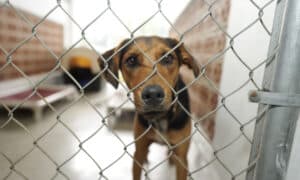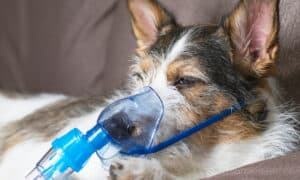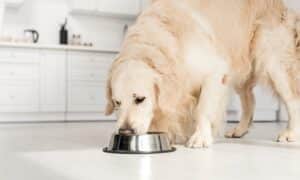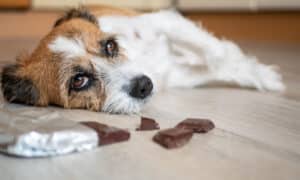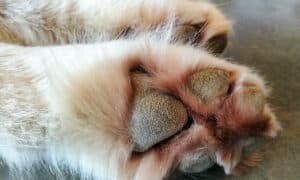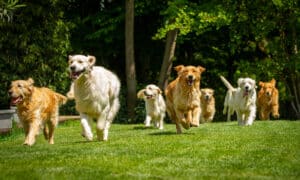“This post contains affiliate links, and I will be compensated if you make a purchase after clicking on my links.”
When it comes to feeding your dog, there’s a thousand schools of thought, a thousand different foods, and a thousand people that’ll all give you a different opinion of what’s right – but, there are 10 commandments that, no matter what or how you feed, must be followed for your dog’s health and wellness.
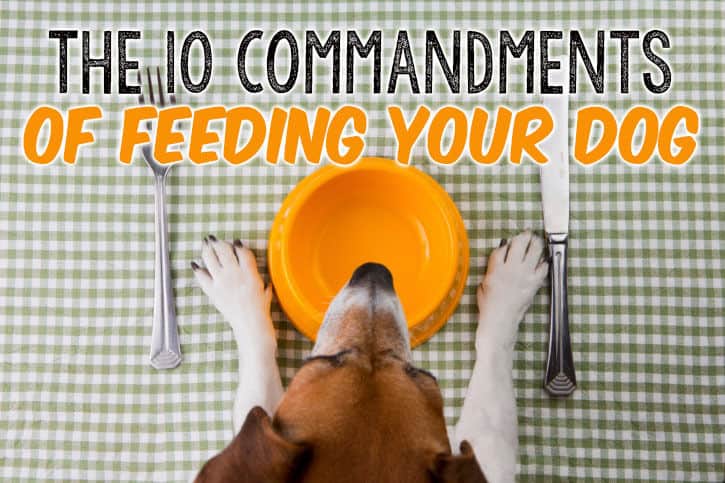
1. Always provide plenty of drinking water.
Fresh, clean water should be available to your dog at all times. In general, healthy dogs should drink about ½ to 1 ounce of water per pound of body weight each day. So, the average 50 pound dog should drink between 25 and 50 ounces (or about 3.125 to 6.25 cups) of water each day. However drinking larger quantities of water should be expected in puppies, lactating mothers, very active or working dogs, and during hot weather.
Check your dog’s water bowl frequently throughout the day to ensure it is filled and that the water is clean and cool. Consider using a pet water fountain to both encourage better drinking habits and to filter out any impurities (including dog hair, dirt, and debris) from water.
2. Choose your dog’s food wisely.
When selecting the right food for your dog, there are four main characteristics to consider:
- your dog’s age (is he a puppy, an adult, or a senior?),
- your dog’s size (small breed or large breed?),
- your dog’s physical activity level (is he a working dog or sporting dog, is he largely inactive?),
- your dog’s general health (does he have any food allergies? Any dietary restrictions? Over- or underweight?).
Different dogs have different nutritional requirements, so taking all of these characteristics into consideration will be important. Despite what many dog food manufacturers imply, there is no one-size-fits-all food that will provide perfect nutrition to all dogs.
Whether you choose to feed dry kibble, wet/canned food, homemade, raw, or a combination of these, be certain that your unique dog’s nutritional needs are met.
3. Always measure your dog’s food.
More than half of all dogs in the U.S. have been found to be overweight or obese, largely as a result of overfeeding and lack of exercise. Dogs that are kept at a healthy, slender weight live longer, healthier, happier lives than those that are even a few pounds overweight. So, feeding a nutritious food, in an appropriate quantity is vital to a dog’s well-being.
Every commercial pet food provides recommendations for feeding. These recommendations are based on your dog’s ideal weight, not their actual weight – this is very important to remember! If your dog is under or overweight, feed a quantity of food appropriate for a dog at the weight he should be. Always use a scale or measuring scoop to accurately measure the appropriate amount to feed.
4. Store your dog’s food appropriately.
Your dog’s food should always be stored in a manner that protects it from pests, mold, moisture, and air. Different types of food will have different storage methods that should always be followed.
Dry kibble should be stored in an air-tight pet food storage container with a lid and kept in a cool, dry environment. Many dog owners simply scoop food from the bag and roll the bag over resulting in food that can go stale, collect moisture, grow mold, or become contaminated. If possible, keep your original pet food packaging in the event of an issue or recall with the food.
Wet or canned foods can be stored sometimes for years in their original sealed packaging. But, once opened, food should be kept covered with a pet food can lid or moved into another sealed container (a strip of foil or plastic wrap does not offer a sufficient seal!) and kept refrigerated for no more than one week.
5. Throw away any uneaten dog food.
When a dog doesn’t eat all of the food in his bowl, many pet parents are tempted to save money by saving the uneaten portion and offering it again at the next feeding. Instead, any uneaten food should be discarded and replaced with fresh food at the next mealtime. This is especially true of wet, canned, or raw foods which should never be left out at room temperature for more than a couple of hours.
6. Feed your dog from an appropriate bowl or dish.
Believe it or not, different dogs have widely different needs (and preferences) when it comes to the type of bowl or dish they eat from!
Some dogs prefer an elevated bowl while others will only eat from a bowl at floor level. Short-faced dogs will find it easier to eat from a shallow dish, while dogs with long, thin snouts fare better in a deep-dish bowl. And, dogs that eat too fast may be better suited to eating from a slow-feeder.
Related: Choosing the Right Dog Food Bowl (Yes, It Matters!)
7. Feed your dog at regularly scheduled mealtimes.
Like you and I, dogs like routine, particularly as it pertains to mealtimes. Imagine if you didn’t know when you’d have a lunch break from day to day! Feeding your dog at regularly scheduled, consistent mealtimes not only provides him with a sense of stability, it offers an excellent opportunity to monitor eating habits and watch for changes.
Although some dogs thrive on a once-per-day, free-feeding method where the full day’s supply of food is provided in the morning, most dogs are better suited to being fed two to three meals spread throughout the day. Allowing your dog to eat at the same time you do is a good schedule – plus, it’ll help keep him from begging for YOUR dinner!
8. Clean your dog’s food and water dishes every day.
For most of us, this one is a no-brainer. After all, we probably wouldn’t eat off the same plate or drink from the same cup day after day without washing it, right?
Food and water dishes should be cleaned and thoroughly washed every day. When feeding wet, canned, or raw food, dishes should be picked up and cleaned immediately after eating (or after a few hours if food is left behind) to prevent the growth of bacteria or attracting pests and insects.
9. Be mindful of extra calories from treats and snacks.
It’s nearly impossible to resist those puppy dog eyes, looking up at you and begging for a treat. And, unless your dog is on a strict diet, you don’t have to! It’s perfectly fine to indulge now and then. Just remember, every time your dog indulges, you’re adding extra calories to his diet and his food should be adjusted accordingly. Dog treats and pet-safe human snacks tend to have far more calories and fat than your dog’s regular food.
This is particularly important for dogs that are being trained using reward-based training where treats are used in celebration of a job well done. Training treats are generally smaller, but packed with calories to make them extra tasty. Just remember to cut back at dinner time if your pup has been well-treated throughout the day.
10. Discuss changes in your dog’s eating habits with your veterinarian.
Because dogs can’t tell us, in no uncertain terms, when they aren’t feeling well, it’s important for responsible pet parents to look for cues.
Loss of appetite, voracious hunger, and increased thirst can all be indications of a more serious issue in your dog. Remember to monitor your dog’s eating and drinking habits, take note of any changes lasting more than 24 hours, and report those changes to your veterinarian.
Found this guide helpful? Like, Share, Tweet, or Pin it for your dog-loving family and friends!


